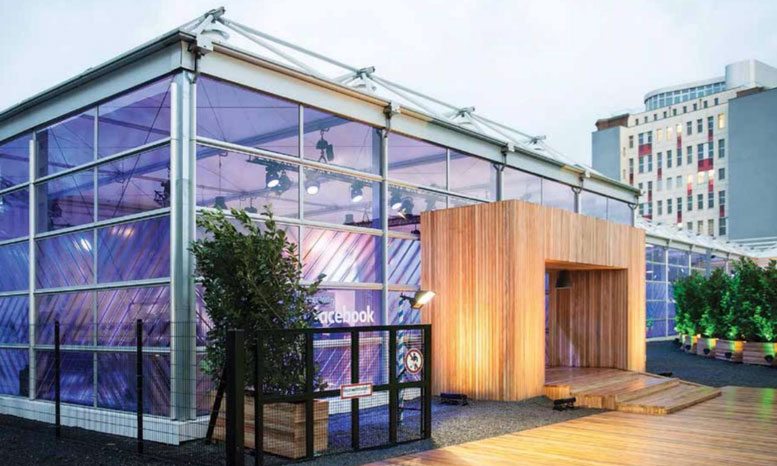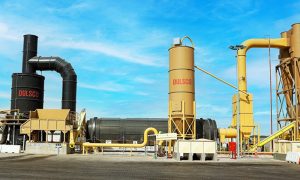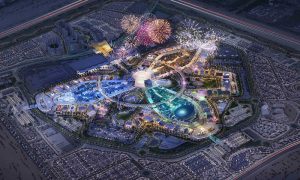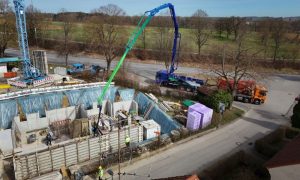Temporary structures business finding permanent space in Gulf market
Industry gets a boost from boom in regional meetings and conferences sector – expert

Edward Gallagher of De Boer Middle East speaks to Big Project ME about how the Dutch temporary structure specialist is building a niche in the UAE and wider GCC market:
What is the demand like for temporary structures in the UAE, and in the wider GCC?
The UAE has always been the major hub for events in the region and this has driven the demand for temporary structures, but we are seeing a move away from traditional ‘tents’ and an increasing demand for more sophisticated, permanent-look structures.
This is an area of specialisation for De Boer. Visitors no longer want to see standard A-frame tents. Instead, inspirational structures are expected, with floor-to-ceiling glazing, clear roof sails, curves, mezzanine floor and even double- and triple-storey buildings with balconies, etc. There is an ever-increasing demand for high-specification and design-led temporary structures, especially in the events sector, and this is expected to continue through to Expo 2020, where some of the most innovative and unique temporary structures that the world has to offer will be unveiled.
Outside of the UAE, economies of other GCC countries are diversifying and in doing so, they are focussing on becoming hubs for MICE [Meetings, Incentives, Conferences & Exhibitions]. Also, their stated objectives are to promote domestic tourism and to attract more international visitors through holding major global events – particularly sporting events (for example, we can look to Qatar with the World Cup and a substantial number of other major championships which have come in the run-up to it, such as the Qatar Masters Golf tournament) – which has a huge impact on the demand for temporary structures.
Of course, the demand for short-term structures in the way you may traditionally think of them, such as temporary hospitality tents, still exists, but with advances in temporary building technology over the last 10 years, we are now building full temporary stadia for major sports events through to huge logistics warehouses used for years in advance of events.
De Boer has even supplied entire turnkey exhibition centres that have been used while upgrades or new permanent centres are constructed. Some of De Boer’s semi-permanent structures have been in daily use for up to 10 years, which demonstrates the durability of some temporary structures.
What applications and industries are your temporary structures used for?
In the semi-permanent structure environment mentioned above, De Boer supplies airport terminals, logistics hubs, storage centres, theatres, schools and a huge range of other fully functioning operational facilities. Things have moved on a long way from the fabric-sided ‘tents’ traditionally thought of when you say temporary structure.

Those products are still available of course, and there is a need for them, but De Boer’s range of semi-permanent solutions have high visual impact, insulation, structural strength and the flexibility of a permanent structure. The difference is that they can be built in weeks instead of years. That has a huge appeal, especially in the Middle East where demand for extra infrastructure is far ahead of the ability of governments or organising bodies to deliver using traditional construction methods.
For example, a De Boer customer had land they wanted to rent out as storage and warehousing in a premium location near a major port. Based on an initial feasibility study, the up-front investment involved and one-year construction time for permanent buildings was not viable. Instead, they found temporary structures to be the solution.
In working with De Boer, this company had their first warehouse built on-site in only five weeks – fully ready to accept their first customer. And consequently, each time a new client has been secured, they have added a new temporary warehouse structure on a lease-to-purchase basis.
This minimised risk by having customers already signed up first and the up-front cash to outlay in a short timeframe. While this concept may not be suitable in every situation, any company or organisation wanting to rapidly mobilise infrastructure, maybe while waiting for permanent facilities to be built, can consider temporary structures without compromising on quality. Today’s temporary structures are ideal growth enablers.
Are you anticipating an increase in demand in the build-up to Expo 2020 and the Qatar World Cup?
Undoubtedly, these mega-events will demand a high volume of temporary infrastructure. Again, these will not only be traditional event structures, such as security tents, temporary hospitality venues, but Expo 2020 will likely use temporary facilities for many years after the event, such as for on-site warehousing and logistics purposes.
The organisers of the 2022 World Cup have committed to fully temporary stadia. It is routine for the host city or country to experience an influx of other large-scale events in the run-up to such global events, so this is likely to drive demand in the years ahead.
We also expect the appetite for innovation to continue to grow, so R&D continues to be a major focus for De Boer. Our unique circular panorama dome structure is an example of this. Major event organisers generally want to wow their audience, so we can expect both Expo 2020 and the World Cup to deploy a range of next-generation temporary structures that will blur the lines between temporary and permanent buildings.
How can your structures help solve some of the major issues facing these events?
Increasingly, clients are demanding more creative and innovative uses for temporary buildings, especially during major permanent construction projects such as new airport and theme park builds. The efficiencies of building a relocatable logistics warehouse on a site are significant – a warehouse that can be moved to another location when the phased construction schedule requires it.
The savings can be huge when you are talking about thousands of truck movements. Furthermore, many mega-events in the past have left an expensive legacy of unused buildings, such as those permanently constructed for the Olympic Games. They have subsequently cost millions to maintain and operate, and in the end many fall into decay. A large number of former Olympic venues in Beijing, Athens and Sochi now lie empty and abandoned because they have no long-term use.
The real legacy-focused countries and organising bodies are now using innovative temporary systems to build temporary venues where no future use for permanent facilities can be seen. These temporary structures can then be dismantled after the event and reused elsewhere.
In fact, we are now seeing the various awarding bodies such as the IOC absolutely insisting on temporary structure use in future bids, making temporary venues an essential part of these large-scale events in the future. Temporary structures are considered to be a more sustainable solution.
How far can the technology around temporary structures go? What future uses can you see for it?
While temporary structures are designed differently than their permanent counterparts, focusing more on lightweight materials with minimal permanent foundations etc, there is very little that temporary buildings cannot do.
While we cannot build a temporary Burj Khalifa tower (yet!), it really comes down to the bespoke designs and totally unique shapes that we can achieve with temporary structures. It is a modular, flexible, systemised approach. De Boer has built schools, shops, warehouses, aircraft hangers, airport terminals, museums and even a prison! In fact, we also built the world’s largest temporary exhibition hall for the Farnborough international Air Show in the UK.
What are your plans for the company in the GCC? What are your targets for 2017?
De Boer is focused on continuing the great momentum and growth experienced over the last three years across the GCC. Fifteen years ago, De Boer was largely active only in Qatar, although we had delivered some work within the UAE. In the last four years in particular, we have expanded our project and operational reach across the region, delivering extensively throughout the UAE, Saudi Arabia and Qatar, with additional projects in Kuwait, Oman and Bahrain.
With the increased awareness of how temporary structures can be used for events and temporary business space needs, we are expecting this upward demand trend to continue as we support major infrastructure projects, including mega-events and mega construction projects in the Middle East region.

























